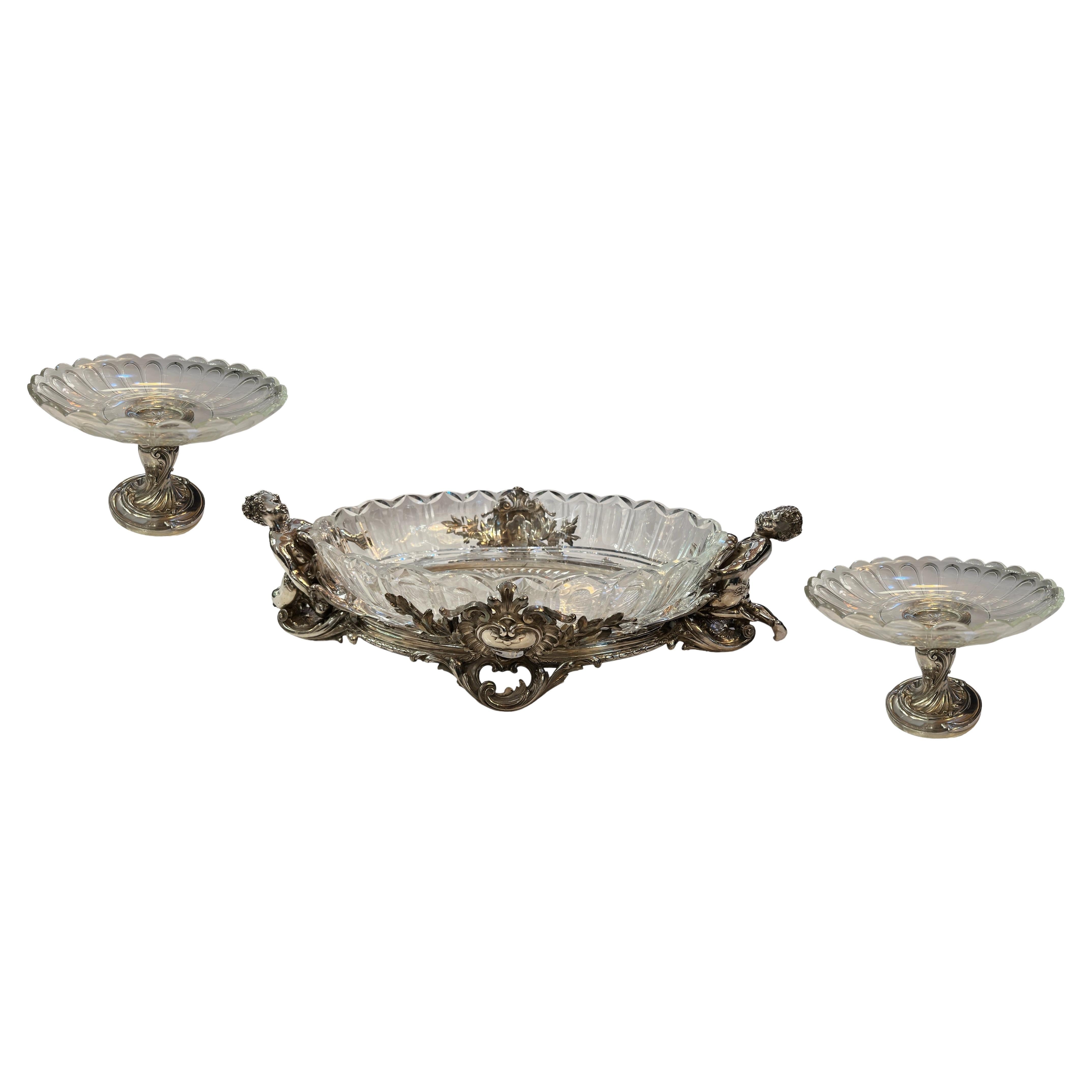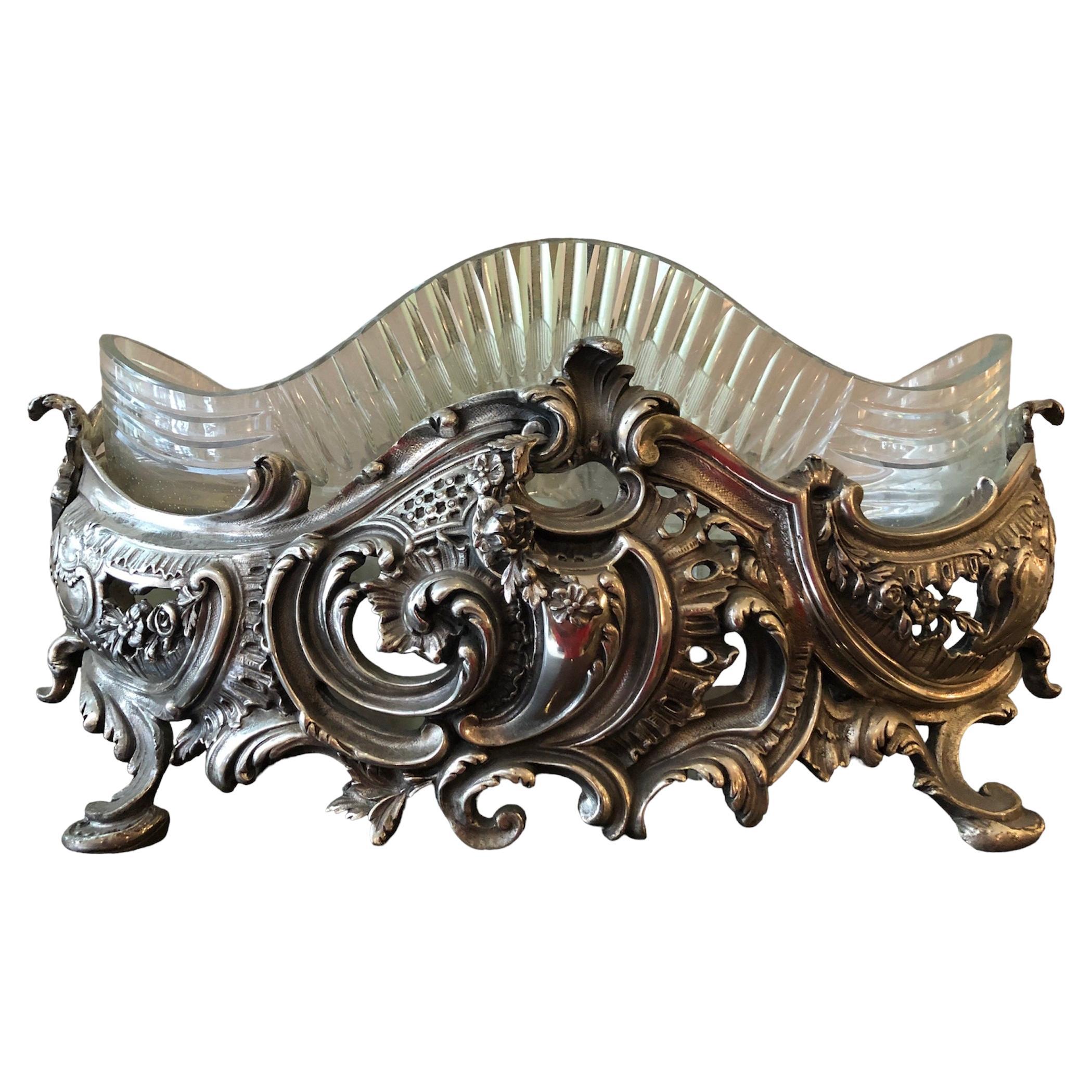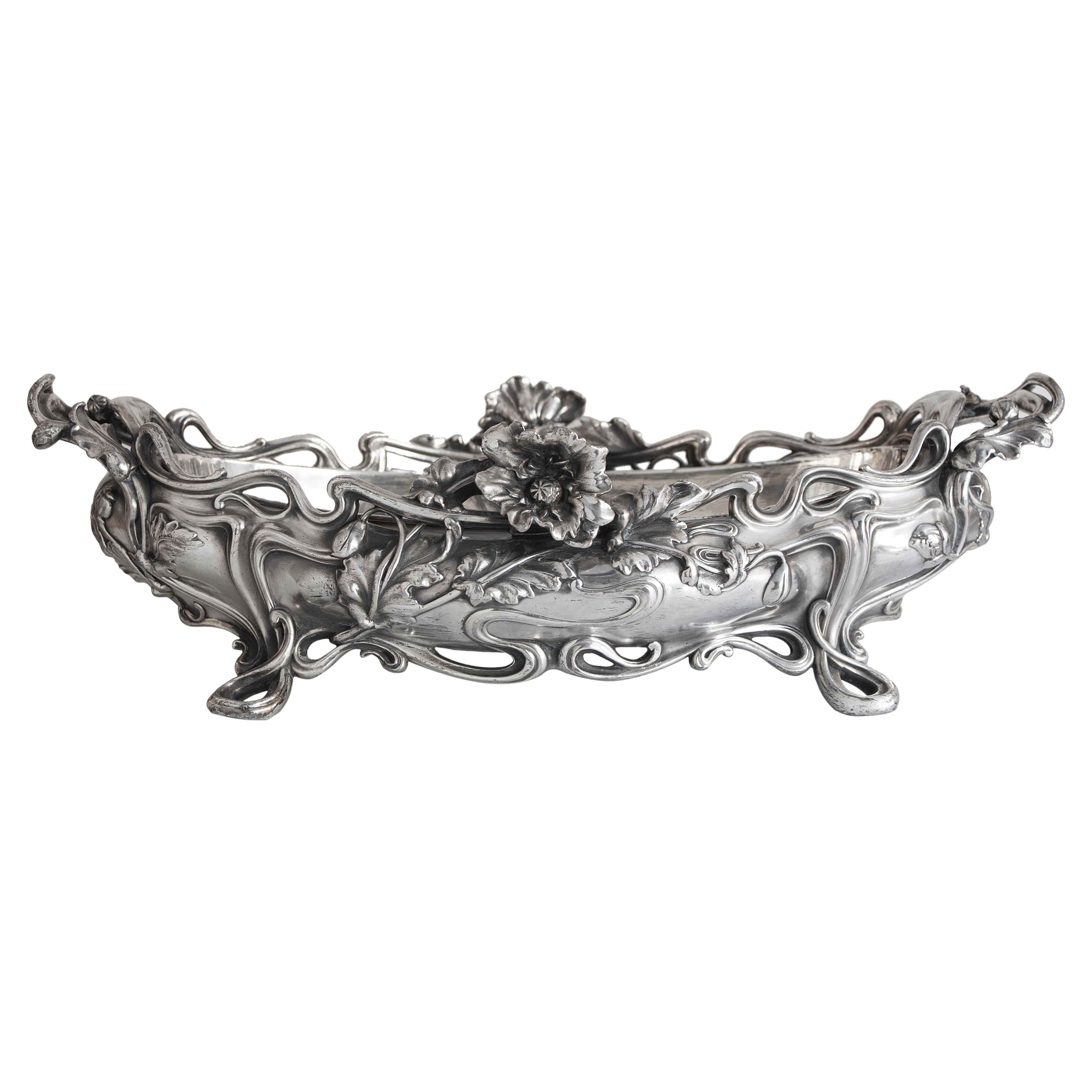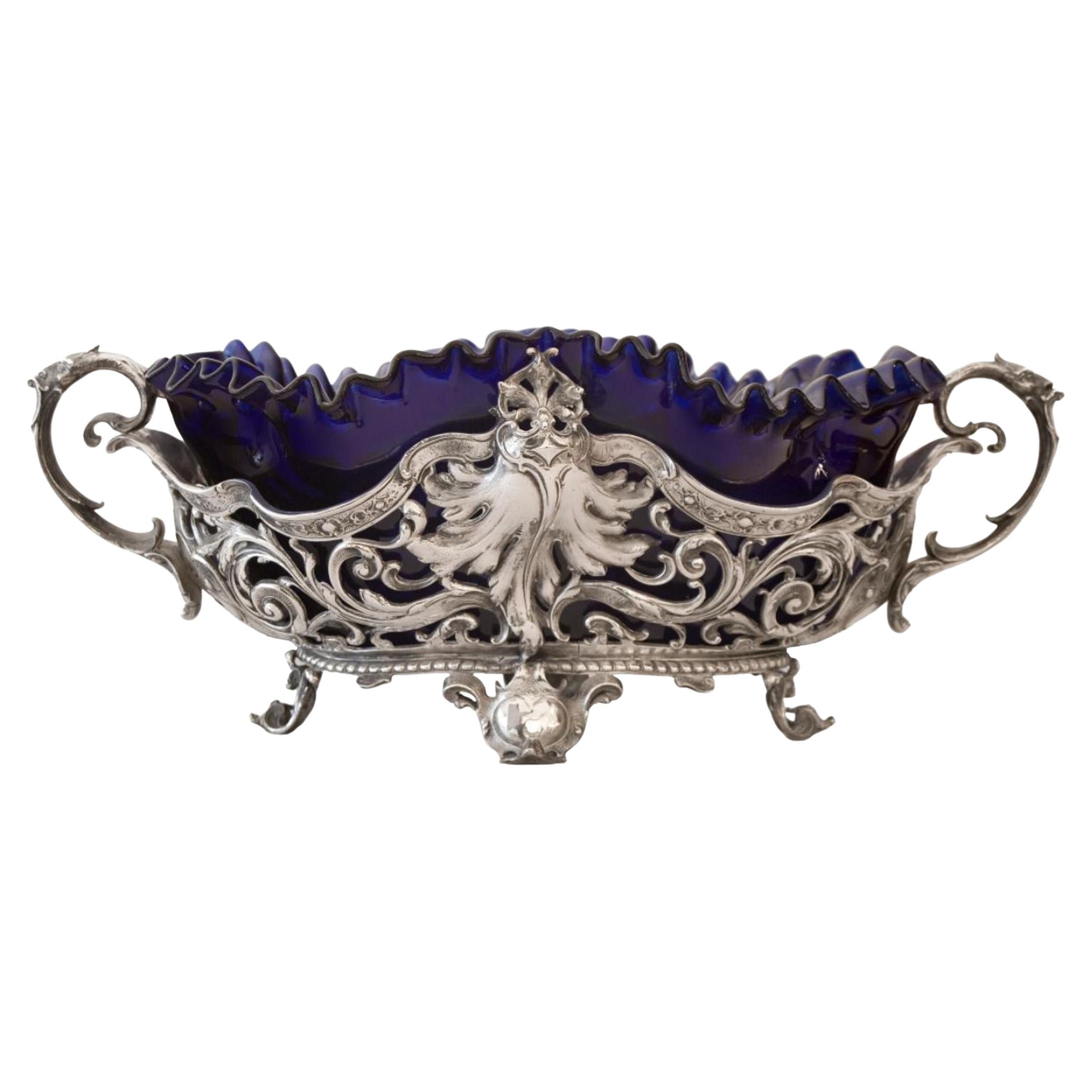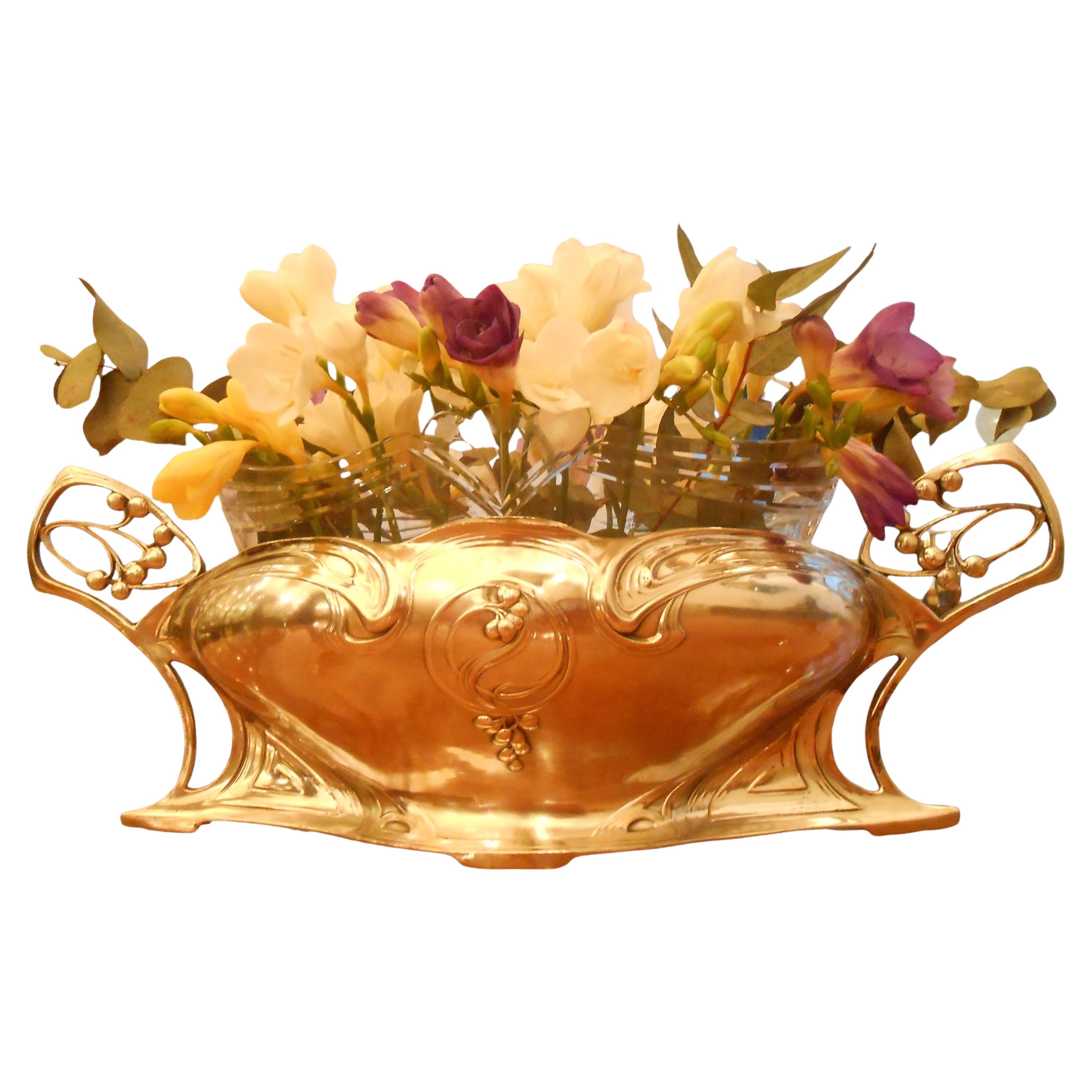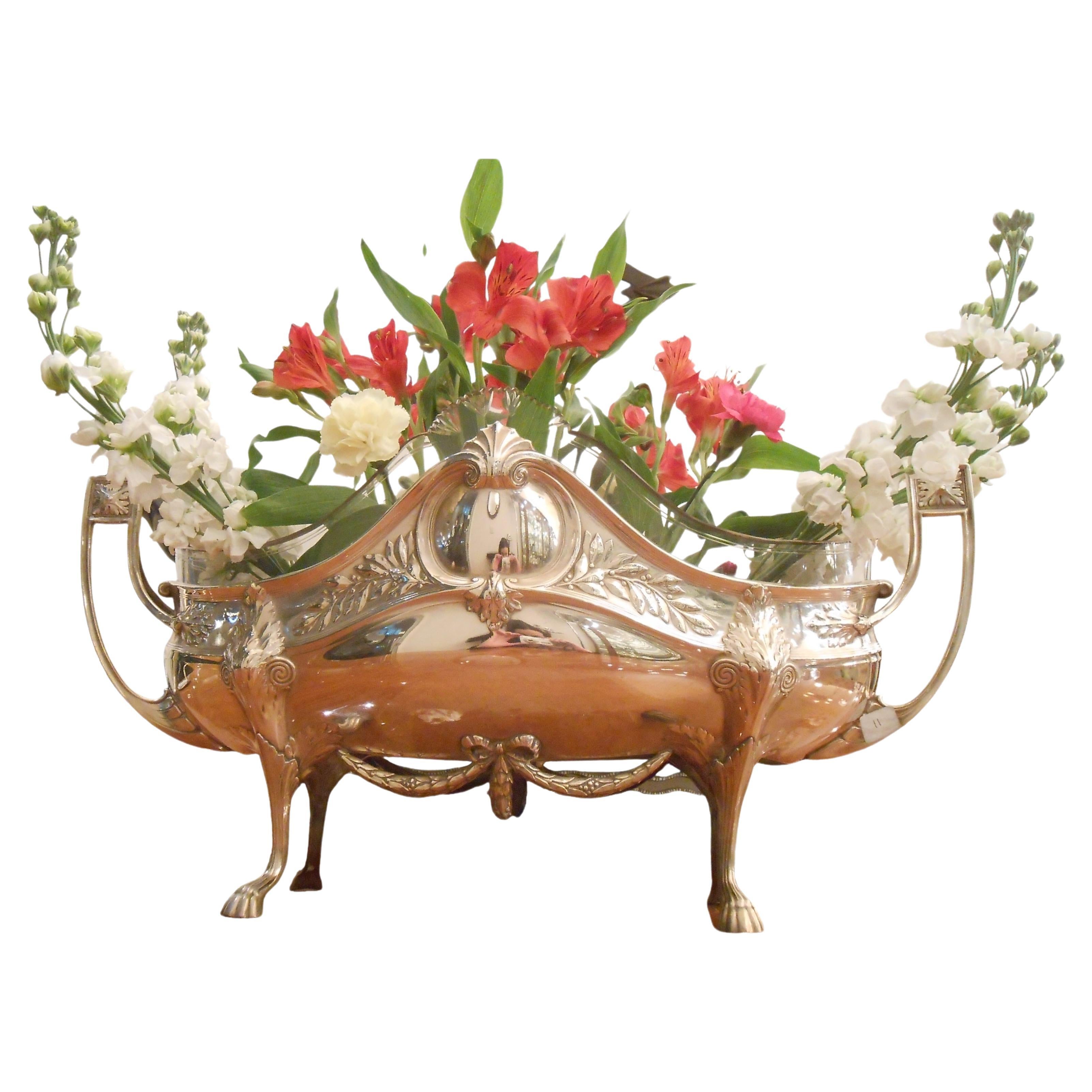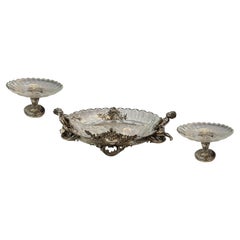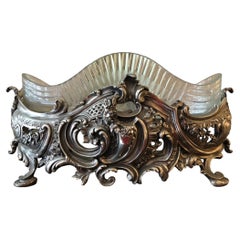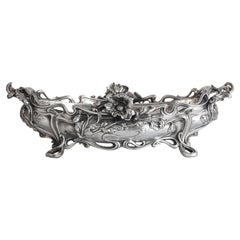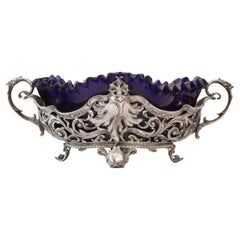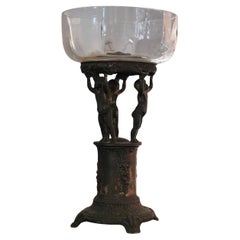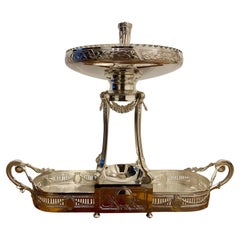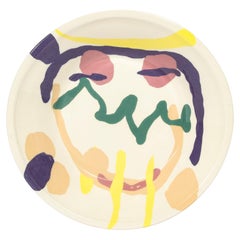Articoli simili a Centerpiece Sign: A. Perron, Art nouveau, Jugendstil, Moderismo, Liberty, 1900
Caricamento del video
Vuoi altre immagini o video?
Richiedi altre immagini o video al venditore
1 di 22
Centerpiece Sign: A. Perron, Art nouveau, Jugendstil, Moderismo, Liberty, 1900
Informazioni sull’articolo
Sign: A. Perron
Charles Théodore Perron, born in 1862, is primarily known for his traditional silverware (objects made of solid silver or silver-plated for domestic use). He was a highly active French sculptor in the late 19th and early 20th centuries. His works often featured Art Nouveau or figurative styles.
The period around 1900 was a "golden age" for electrochemical silver plating, as the demand for elegant, luxurious-looking objects grew significantly. Artists like Perron applied patinas to their sculptures to give them a specific finish and color. These patinas could be various shades, including those that created a bright metallic appearance or even an effect reminiscent of oxidized or aged silver, even if the pieces weren't pure silver.
Why are there so many antiques in Argentina?
In the 1880 – 1940 there was a grate wave of immigration encouraged by the periods of war that were taking place.
1st World War took place between 1914 and 1918
2nd World War took place between 1939 and 1945
The immigrants options were New York or Buenos Aires. Tickets were cheap and in Buenos Aires they were welcomed with open arms, as it was a country where everything was still to be done.
Argentina was the country of new opportunities, labour was needed and religious freedom was assured, in many cases the of the family travel first until they were settled and then the rest of the family members join them.
In the immigrant museum “Ellis Island Immigrant Building” in New York you can se the promotional posters of the boats that would take them to a new life.
Between the years 1895 and 1896, Argentina had the highest DGP (gross domestic product) per capita in the world according to the Maddison Historical Statistics index, this situation arose due to the large amount of food being exported to European countries, which were at war.
The Argentinean ships left the port of Buenos Aires with food, but they returned with furniture, clothes and construction elements, (it´s common to see this the old buildings of the historic neighbourhood of San Telmo, the beams with the inscription “Made in England)”, as well as many markets that were built in Buenos Aires, such us the San Telmo Market, whose structure was brought by ship and afterwards assembled in 900 Defensa Street.
With the great influence of European immigrants living in the country, the children of the upper classes travelled to study in France, resulting in the inauguration of “La Maison Argentinienne”, on 27th of June 1928, in the international city of Paris, which hosted many Argentinians that were studying in Frace.
It´s the fourth house to be built after France, Canada and Belgium, being the first Spanish-speaking one. Still in place today (17 Bd Jourdan, 75014, Paris, France). Many of the children of these wealthy families who attended international art exhibitions, museums and art courses abroad, took a keen interest in the European style. This is why Buenos Aires was at the time referred as “The Paris of South America”.
Between the years 1890 and 1920 more than a hundred Palaces were built on Alvear Avenue the most exclusive avenue in Buenos Aires. Today some of these palaces have been transformed into museums, hotels and embassies.
In the year 1936, the Kavanagh building was inaugurated, it was the tallest reinforced concrete building in South America.
During 1994 the American Society of Civil Engineers distinguished it as an “international engineering milestone”, and it´s now considered a World Heritage of Modern Architecture.
At the time was common to hire foreign architects such as Le Corbusier, who visited Buenos Aires/Argentina in 1929 and in 1948 he drew up the blueprints for a house built in La Plata City (which was declared a World Heritage Site).
In 1947, the Hungarian architect Marcelo Breuer designed “Parador Ariston” in the seaside city of Mar del Plata. After an Argentinean student at Harvard University convinced him to come to Argentina. He worked on an urban development project in the Casa Amarilla, area of La Boca.
The Ukrainian architect, Vladimiro Acosta, arrives in Argentina in 1928 and worked as an architect until que moved to Brazil.
Antonio Bonet, a Spanish architect who worked with Le Corbusier in Paris, arrives in Argentina in 1937, where he carried out several architectural works and in 1938 designs the well-known BFK chair.
Andres Kálnay, of Hungarian origin, made around 120 architectural masterpieces, among which the former Munich brewery stands out, he even made the furniture’s design.
The German architect, Walter Gropius, director of the Bauhaus, lived in Argentina, where he wrote articles for “Sur” magazine and founded in Buenos Aires, an architectural firm with Franz Möller, who was also an architect, where he built two houses.
At the same time several famous designers decided to immigrate to Argentina, among them we can find the well-known French designer, Jean-Michel Frank, who arrived in the country in 1940 and also worked for the Rockefeller family.
Special pieces were made, which were sold exclusively in the country, such as the well-known German company “WMF”, who sold their products by catalogue, which were chosen by the ladies of high society in the list of wedding gifts, as well as the pieces designed by Christofle.
The Swiss sculptor Alberto Giacometti, made special pieces for Argentinean mansions.
In 1904 the first Jansen branch outside Paris was established in Buenos Aires, as the Argentinean clientele demanded a large amount of furniture, from the end of the 19th century to the mid-20th century.
In 1970, the brand Rigolleau Argentina made pieces authorised by Lalique.
The brands Maple and Thompson also set up shop in the country.
The French plastic artist, Marcel Duchamp moved to Argentina in 1918-1919.
Glass signed Gallé, Charder, Leverre, Schneider, Muller and other French firms. They were bought in flower shops and were given to ladies with beautiful floral arrangements.
Some furniture manufacturers travelled to international fairs and bough the patterns to produce the furniture in Argentina, such as the furniture firm Englander and Bonta, who bought the patterns ins Italy.
It is worth mentioning that in Argentina we have the largest community of Italians outside of Italy, as it is estimated that 70 percent of the inhabitants have at least one Italian descendant, followed by Spanish immigrants.
The most Important furniture stores in Argentina:
Comte is founded in 1934 (under the direct management of Jean Michel Frank in 1940).
Nordiska (Swedish company established in 1934).
Churba in 1960, a company that brought foreign designers to present their furniture in the country:
Denmark: (Arne Jacobsen, Finn Juhl, Bender Madsen, Ejner Larsen, Poul Kjaerholm, Hans Wegner)
Sweden: (Hans Agne Jakobsson, Gustavsberg)
United States: (Herman Miller)
Finland: (Lisa Johansson, Folke Arstrom, Tapio Wirkkala, Alvar Aalto, Timo Sarpaneva)
Swedish Factory: (Orrefors)
Italy: (Littala, Vico Magistretti, Emma Gismondi, Gae Aulenti, Angelo Mangiarotti, Elio Martinelli, Gianna Celada, Angelo Mangiarotti, Mario Bellini, Carlo Scarpa)
Finland: (Olivia Toikka)
Plata Lappas (Lappas Silver): a goldsmith shop founded in 1887 in Argentina by Alcibiades Lappas of Greek origin.
In 2019, in Argentina took place “the Art Deco world congress”, in which we participated as hosts invited by Geo Darder, founder of the Copperbridge – Foundation, in which prominent people from all over the world attended to learn about Art Deco in Argentina.
Argentina currently has more than 100 Art Deco buildings and another 90 Art Nouveau buildings throughout the city of Buenos Aires.
Argentina is a country that has not been involved in many wars, which is why it has been a refuge for works of art and antiques from different periods of time, unlike European countries. That is way many collectors, museums and antique dealers from all over the world visit it, you should not miss the opportunity to visit this great country.
Laura Guevara Kjuder, architect.
- Dimensioni:Altezza: 26 cm (10,24 in)Larghezza: 54 cm (21,26 in)Profondità: 20 cm (7,88 in)
- Stile:Art Nouveau (Del periodo)
- Materiali e tecniche:
- Luogo di origine:
- Periodo:1900-1909
- Data di produzione:1900
- Condizioni:Usura compatibile con l’età e l’utilizzo.
- Località del venditore:Ciudad Autónoma Buenos Aires, AR
- Numero di riferimento:Venditore: M-211stDibs: LU6785245194072
Informazioni sul venditore
5,0
Venditore professionale selezionato
Ogni venditore supera rigorosi standard di autenticità e affidabilità
Fondazione nel 1982
Venditore 1stDibs dal 2022
36 vendite su 1stDibs
Tempo di risposta standard: <1 ora
- SpedizioneRecupero del preventivo…Spedizione da: Ciudad Autónoma Buenos Aires, Argentina
- Politica di reso
Alcune parti di questa pagina sono state tradotte automaticamente. 1stDibs non può garantire che le traduzioni siano corrette. L’inglese è la lingua predefinita del sito.
Garanzia di autenticità
Nell’improbabile caso in cui si verifichi un problema con l’autenticità di un articolo, contattaci entro un anno per ottenere un rimborso completo. DettagliGaranzia di rimborso
Se il tuo articolo non corrisponde alla descrizione, è danneggiato durante il trasporto o non arriva, contattaci entro 7 giorni per un rimborso completo. DettagliAnnullamento entro 24 ore
Hai un periodo di tolleranza di 24 ore per annullare il tuo acquisto, senza necessità di fornire spiegazioni.Venditori professionali selezionati
I nostri venditori di livello internazionale devono aderire a rigorosi standard di servizio e qualità, garantendo l’integrità delle inserzioni.Garanzia miglior prezzo
Se scopri che un venditore ha pubblicato altrove lo stesso articolo a un prezzo più basso, applicheremo lo stesso prezzo.Consegna globale affidabile
La nostra rete di vettori leader del settore offre opzioni di spedizione specializzate in tutto il mondo, inclusa la consegna personalizzata.Altro da questo venditore
Mostra tutto3 Centrotavola, Jugendstil, Art Nouveau, Liberty, Francia, 1900, Segno:Christofle
Di Christofle
3 pezzi Christofle
Misure: Bigli Centerplace
65 cm (24,80 pollici) di lunghezza x 18 (7,08) di altezza x 39 (15,35) di profondità (cm)
Bronzo argentato e cristallo
Segno: Christofl...
Categoria
Di antiquariato/d’epoca, Inizio Novecento, Francese, Art Nouveau, Centro...
Materiali
Cristallo, Bronzo
Centrotavola, Francia, Jugendstil, Art Nouveau, Liberty, 1900
Centerplace
In bronzo argentato
Dal 1982 siamo specializzati nella vendita di oggetti in stile Art Déco, Art Nouveau e Vintage. Per qualsiasi domanda siamo a vostra disposizione.
Pre...
Categoria
Di antiquariato/d’epoca, Inizio Novecento, Francese, Art Nouveau, Centro...
Materiali
Bronzo
Centrotavola, Jugendstil, Art Nouveau, Liberty, Francia, 1900
Centerplace
Argentato
Dal 1982 siamo specializzati nella vendita di oggetti in stile Art Déco, Art Nouveau e Vintage. Per qualsiasi domanda siamo a vostra disposizione.
Premendo...
Categoria
Di antiquariato/d’epoca, Inizio Novecento, Francese, Art Nouveau, Centro...
Materiali
Metallo
Centrotavola, Tedesco, Jugendstil, Art Nouveau, Liberty, 1900
Di WMF Württembergische Metallwarenfabrik
Centerplace, WMF, Tedesco
Aziende:
WMF G con struzzo = Il primo marchio impresso WMF, utilizzato dal 1880 al 1925 per gli oggetti cavi placcati in argento e fino al 1930 per gli ...
Categoria
Di antiquariato/d’epoca, Inizio Novecento, Tedesco, Art Nouveau, Centrot...
Materiali
Cristallo, Metallo
Centrotavola WMF, Tedesco, Jugendstil, Art Nouveau, Liberty, 1900
Di WMF Württembergische Metallwarenfabrik
Centerplace, WMF, Tedesco
Pagina: 91 nel Libro - Art Nouveau domestico Lavorazione del metallo da WMF Wurttembergische Metallwarenfabrik: il catalogo inglese 1906 con copertina ri...
Categoria
Di antiquariato/d’epoca, Inizio Novecento, Tedesco, Art Nouveau, Centrot...
Materiali
Cristallo, Metallo
Centrotavola WMF, Tedesco, Jugendstil, Art Nouveau, Liberty, 1900
Di WMF Württembergische Metallwarenfabrik
Centerplace, WMF, Tedesco
WMF (Wurttembergische Metallwarenfabrik)
L'Electro-Wurtemberg Plate Company di Geislingen, in Germania, oggi nota a livello internazionale come "WMF", sigla...
Categoria
Di antiquariato/d’epoca, Inizio Novecento, Tedesco, Art Nouveau, Centrot...
Materiali
Cristallo, Metallo
Ti potrebbe interessare anche
Ciotola Liberty in vetro Antimonio, Italia 1900
Alzata per dolci in stile Art Nouveau, prodotta in Italia negli anni '20, realizzata in fusione di antimonio con ciotola superiore in vetro. La base, solida e leggermente brunita dal...
Categoria
Di antiquariato/d’epoca, Inizio XIX secolo, Italiano, Art Nouveau, Centr...
Materiali
Metallo
Centrotavola francese Art Nouveau argentato "Epergne", ca. 1900
Centrotavola francese Art Nouveau argentato "Epergne", ca. 1900.
Categoria
Di antiquariato/d’epoca, Inizio Novecento, Francese, Art Nouveau, Centro...
Materiali
Placcato argento
Grande ciotola centrotavola in ceramica dipinta a mano firmata Jurg Lanrein
Questa splendida ciotola modernista in ceramica di grandi dimensioni è stata realizzata dall'acclamato artista Jurg Lanrein in Svizzera nella seconda metà del XX secolo. Presenta un'...
Categoria
XX secolo, Svizzero, Moderno, Alzate, vassoi e piatti da portata
Materiali
Ceramica
WMF Vassoio portacarte centrotavola in argento Art Nouveau Jugendstil, Germania, 1910 ca.
Di WMF Württembergische Metallwarenfabrik, Albert Mayer
Un bellissimo vassoio o tazza da centrotavola in argento Jugendstil in stile art nouveau con una ninfa che tiene in mano una colomba, realizzato da WMF in Germania nel 1910 circa.
...
Categoria
Vintage, Anni 1910, Tedesco, Art Nouveau, Centrotavola
Materiali
Placcato argento
Centrotavola Baccarat Art Nouveau
Di Baccarat
Questa straordinaria e rara coppia di centrotavola mette in mostra la maestria del cristallo Baccarat. In stile Art Nouveau, i centrotavola sono caratterizzati da grandi vasi di vetr...
Categoria
Di antiquariato/d’epoca, XIX secolo, Francese, Art Nouveau, Cristallerie
Materiali
Cristallo
16.850 USD
Centrotavola in argento in stile liberty
Questo elegante e bellissimo centrotavola è stato realizzato in Germania, intorno al 1900. È un meraviglioso esempio di Art Nouveau e la forma organica fa sì che, come una scultura i...
Categoria
Inizio XX secolo, Tedesco, Art Nouveau, Centrotavola
Materiali
Argento
